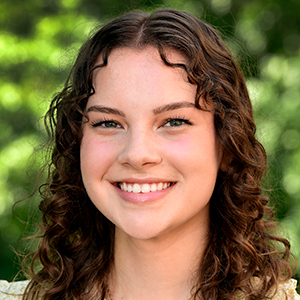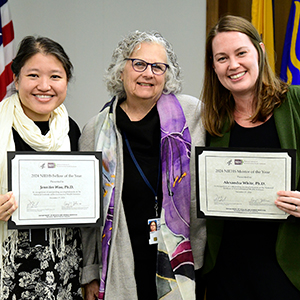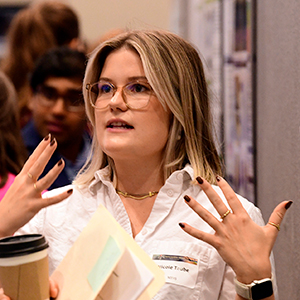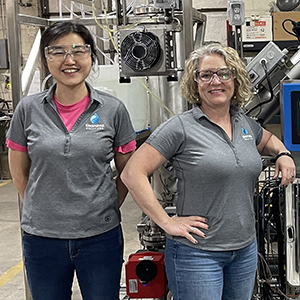Seven trainees with the NIEHS Superfund Research Program (SRP) have earned K.C. Donnelly Externship Award Supplements. Named for longtime SRP grantee Kirby “K.C.” Donnelly, the funding enables graduate students and postdoctoral researchers to learn techniques relevant to their work from experts at outside institutions.
Donnelly’s commitment to mentoring students and fostering research partnerships was a career hallmark. By promoting collaboration across other SRP centers and agencies, the eponymous awards enable knowledge-sharing and skill-building essential to forging scientific careers.
The 2022 awardees are Laura Dean, Ph.D.; Rebecca Dickman; Avinash Kumar, Ph.D.; Francisco Léniz; Martine Mathieu; Charlotte Wirth; and Melissa Woodward. Their research projects are discussed below.
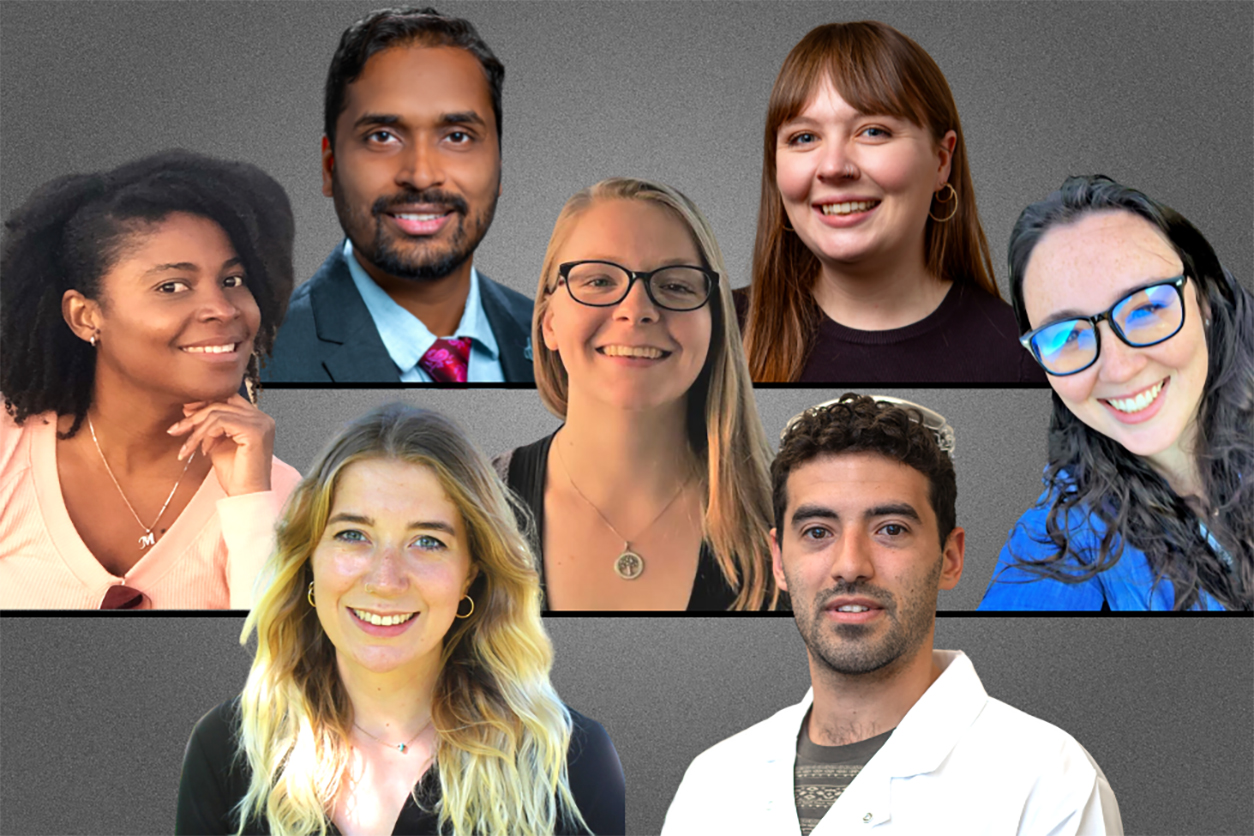 The K.C. Donnelly Awards enable graduate students and postdoctoral researchers to study with experts at outside institutions. Top row, from left: Kumar and Dickman. Middle row, from left: Mathieu, Wirth, and Dean. Bottom row, from left: Woodward and Léniz. (Image courtesy of MDB, Inc.)
The K.C. Donnelly Awards enable graduate students and postdoctoral researchers to study with experts at outside institutions. Top row, from left: Kumar and Dickman. Middle row, from left: Mathieu, Wirth, and Dean. Bottom row, from left: Woodward and Léniz. (Image courtesy of MDB, Inc.)Tackling PCBs
Laura Dean, Ph.D., is a postdoctoral research scholar with the University of Iowa (UI) SRP Center. Her externship will take place at the National Center for Toxicology Research, a branch of the U.S. Food and Drug Administration, in Jefferson, Arkansas.
Dean plans to use human-derived liver cell cultures to study the role of cytochrome P450 proteins — which process foreign chemicals — in metabolizing airborne polychlorinated biphenyls (PCBs). The research could inform future studies that assess PCB breakdown by cytochrome P450s in the brain.
“My goal is to become an analytical and forensic toxicologist,” Dean said. “I’m excited to learn new techniques and experience what it’s like to work in a government agency lab.”
PFAS research
Rebecca Dickman is a doctoral candidate at the State University of New York at Buffalo, where she works with Diana Aga, Ph.D., an SRP individual research project grantee. She will complete a remote externship with the U.S. Environmental Protection Agency in Research Triangle Park, North Carolina.
Dickman aims to evaluate how the presence of other compounds affect the behavior of per- and polyfluoroalkyl substances (PFAS) during chemical analysis. That data will inform a preliminary computer model designed to quantify unknown PFAS in complex mixtures. Ultimately, such a model could be used to measure the efficacy of remediation efforts to break down PFAS in environmental samples.
“Through this opportunity, I hope to sharpen my skills in data science and computational chemistry while improving techniques for identification and quantification of unknown PFAS,” Dickman said.
Combustion byproducts
Avinash Kumar, Ph.D., a post-doctoral researcher with the Louisiana State University SRP Center, plans to complete an externship at the University of North Carolina at Chapel Hill SRP Center.
There, Kumar will learn new techniques to analyze microorganisms and metabolic byproducts in mice that have been exposed to environmentally persistent free radicals (EPFRs), a type of combustion byproduct. The goal is to better understand how an imbalance in microbial communities can affect the severity of influenza stemming from EPFR exposure.
“Growing up in a rural area, I witnessed a lack of facilities and treatment options,” Kumar said. “I feel obligated to improve understanding of common but rampant pathologies like influenza infection, nutritional disorders, inflammation, and metabolic disorders.”
Filtering PFAS from water
Francisco Léniz is a doctoral candidate at the University of Kentucky SRP Center. His externship at Yale University, in collaboration with the Harvard SRP Center, will build on his earlier work to create an artificial membrane that filters PFAS from water.
Léniz will learn about technologies for separating arsenic from water, with the aim of developing a more efficient platform for treating water containing the toxic element and other substances of concern.
“This opportunity will help me enhance my skills as a researcher and expand my collaborative work to ultimately provide innovative solutions to environmental health problems,” Léniz said.
Predicting air pollution dispersion
Martine Mathieu is a doctoral candidate at North Carolina State University working with the Louisiana State University (LSU) SRP Center, where she uses spatial and statistical modeling to study particulate matter, such as EPFRs, emanating from a Superfund site in Louisiana.
During her externship at the UI SRP Center, she will learn how to use AERMOD, a software program that predicts air pollutant dispersion from its source. Ultimately, Mathieu plans to integrate various air quality data into a model that estimates pollutant exposure levels based on chemical concentrations.
“The knowledge I gain will enhance my understanding of EPFR toxicity and lung disease,” Mathieu said. “I also look forward to broadening my professional network and helping the LSU SRC and UI SRP centers collaborate.”
Lead exposure and cellular stress
Charlotte Wirth is a doctoral candidate at the Harvard University SRP Center. Her externship will entail research at the University of California, Berkeley SRP Center, where she will apply a molecular labeling technique to a culture of immune cells called microglia to see whether lead exposure increases cellular stress.
Wirth hypothesizes that cellular stress may trigger the release of molecular signals from microglia that might contribute to inflammation and neurotoxicity associated with lead exposure. Her findings could help inform the identification of biomarkers, or biological signs, of cognitive disorders.
“As a tutor or teaching assistant for eight classes in my undergraduate career, I developed a passion for inspiring scientific interest in others,” Wirth said. “I hope to apply what I learn using the chemical labeling technique to my thesis work and to training others.”
Developing tools to measure pollutants
Melissa Woodward, a doctoral candidate at the University of Rhode Island SRP Center, will travel to the Duke University SRP Center for her externship.
Woodward’s graduate work involves developing sampling devices from resin-filled plastic tubes that absorb PFAS in air. At Duke, Woodward will learn a new analytical technique for identifying PFAS in field samples. She will also investigate whether her samplers can measure other air pollutants, such as organophosphate esters.
“My goal is to create tools that can measure a wide scope of pollutants in different environmental situations,” Woodward said. “By learning where they are, we can better understand human and animal exposure to these contaminants.”
(Julie Leibach is a senior science writer at MDB, Inc., a contractor for the NIEHS Superfund Research Program.)






